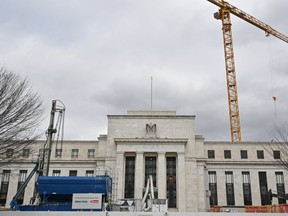In a recent interview with Financial Post’s Larysa Harapyn, Dylan Smith, senior economist at Rosenberg Research, discussed the United States Federal Reserve’s plans for an easing cycle starting in September. According to Smith, the Fed will initiate a "fairly aggressive" easing cycle, which may have significant implications for the global economy.
The Easing Cycle: What to Expect
Smith’s prediction of a "fairly aggressive" easing cycle suggests that the Fed will implement a series of interest rate cuts and other monetary policy measures to stimulate economic growth. This move is likely in response to weakening economic indicators, including slowing GDP growth and rising unemployment.
Why an Easing Cycle Now?
The decision to initiate an easing cycle now may seem counterintuitive, given the strong labor market and steady GDP growth. However, Smith argues that the Fed’s actions are aimed at preventing a potential recession and mitigating the impact of various economic headwinds, such as trade tensions and global economic uncertainty.
How Will This Affect Markets?
The announcement of an easing cycle is likely to have a significant impact on financial markets. Lower interest rates can lead to increased borrowing and spending, which can boost economic growth in the short term. However, sustained low interest rates can also lead to asset price inflation and increase the risk of a future crisis.
Comparison with Previous Easing Cycles
While Smith’s prediction of a "fairly aggressive" easing cycle may seem ominous, it is worth noting that this move is not unprecedented. The Fed has initiated similar easing cycles in the past, including the 2008 financial crisis and the 2015-2016 oil price shock.
Potential Risks and Challenges
While an easing cycle can provide temporary relief to the economy, there are potential risks and challenges associated with this move. For example:
- Asset Price Inflation: Sustained low interest rates can lead to asset price inflation, which can increase the risk of a future crisis.
- Currency Depreciation: An easing cycle can lead to currency depreciation, making imports more expensive and potentially exacerbating inflation.
- Credit Bubble Formation: Easy monetary policy can contribute to credit bubble formation, leading to increased borrowing and spending that may not be sustainable.
Conclusion
In conclusion, the United States Federal Reserve’s plans for a "fairly aggressive" easing cycle starting in September have significant implications for the global economy. While this move is aimed at preventing a potential recession and mitigating economic headwinds, there are potential risks and challenges associated with an easing cycle.
Recommendations
Based on Smith’s analysis, we recommend:
- Monitoring Economic Indicators: Keep a close eye on economic indicators, including GDP growth, unemployment rates, and inflation.
- Adjusting Investment Portfolios: Consider adjusting investment portfolios to reflect changes in market expectations and potential risks associated with an easing cycle.
- Diversifying Assets: Diversify assets to minimize exposure to asset price inflation and credit bubble formation.
By understanding the implications of the Fed’s plans, investors can make informed decisions about their portfolios and position themselves for success in a rapidly changing economic landscape.



